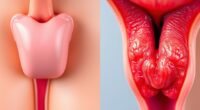To manage hot flashes without HRT, focus on lifestyle changes like wearing breathable clothing, keeping your environment cool, and staying well-hydrated with water and cooling foods. Incorporate phytoestrogen-rich foods like soy and flaxseeds, practice relaxation techniques such as deep breathing and meditation, and engage in regular exercise. Using herbal remedies and stress-reduction methods can also help. For more tips on natural approaches, you’ll find effective options that fit into your daily routine.
Key Takeaways
- Implement dietary changes like consuming phytoestrogen-rich foods (soy, flaxseeds) and cooling, hydrating snacks to reduce hot flash frequency.
- Practice relaxation techniques such as deep breathing, meditation, and yoga to manage stress and lessen symptom severity.
- Maintain a cool environment, wear breathable clothing, and use fans to help control body temperature during hot flashes.
- Engage in regular exercise, including aerobic and strength training, to improve overall well-being and reduce hot flash episodes.
- Avoid triggers like spicy foods, caffeine, and alcohol, and stay well-hydrated with water and herbal teas for natural symptom relief.
Dietary Strategies to Reduce Hot Flashes

Dietary choices can play a significant role in managing hot flashes. You might notice that certain foods trigger or worsen your symptoms, so paying attention to your diet is essential. Limit spicy foods, caffeine, and alcohol, as they can increase body temperature and provoke hot flashes. Incorporate cooling, hydrating options like water, herbal teas, and fresh fruits, which help regulate your body temperature. Eating smaller, more frequent meals can also prevent sudden temperature spikes caused by blood sugar fluctuations. Additionally, avoid high-fat and processed foods that can exacerbate discomfort. Consuming cranberry juice in moderation may offer antioxidant benefits that support overall health, though its effect on hot flashes is still being studied. By making mindful adjustments to your diet, you empower yourself to reduce the intensity and frequency of hot flashes, creating a more comfortable daily routine without relying on hormone therapy.
Incorporating Phytoestrogens Into Your Diet

Incorporating phytoestrogens into your diet can be a natural way to help balance hormone levels and reduce hot flashes. These plant compounds mimic estrogen and may ease menopausal symptoms. You can include them through foods like soy, flaxseeds, and legumes. To give you a clearer picture, here’s a quick guide:
| Food | Serving Suggestions | Phytoestrogen Content |
|---|---|---|
| Soybeans | Tofu, edamame, soy milk | High |
| Flaxseeds | Add ground seeds to smoothies | Very high |
| Lentils | Incorporate into soups or salads | Moderate |
| Chickpeas | Roast or add to stews | Low |
Adding these foods regularly can help support hormone balance naturally. Growing chia seeds is another excellent way to incorporate these beneficial seeds into your diet, as they are rich in nutrients and easy to grow at home.
Staying Hydrated and Choosing Cooling Foods

Staying well-hydrated helps keep hot flashes in check by regulating your body temperature. Incorporate cooling foods like cucumbers, watermelon, and mint to soothe discomfort. These simple choices can make a noticeable difference in managing symptoms naturally. For added comfort, consider incorporating cozy textiles like lightweight blankets or breathable bedding to help regulate your body’s temperature during the night.
Hydration’s Role in Flashes
Have you ever noticed how staying properly hydrated can help keep hot flashes at bay? When you’re well-hydrated, your body can better regulate temperature and dissipate heat, reducing the intensity and frequency of flashes. Drinking plenty of water throughout the day keeps your skin moist and supports overall circulation, which is essential during hot flashes. Avoid sugary or caffeinated drinks, as they can trigger dehydration or worsen symptoms. Instead, opt for water, herbal teas, or infused waters with slices of citrus or cucumber for added cooling effects. Proper hydration also helps prevent headaches, fatigue, and dizziness that sometimes accompany hot flashes. Incorporating hydration strategies such as electrolyte-rich drinks can further enhance your body’s cooling ability. Staying consistent with fluid intake is a simple, effective way to support your body’s natural cooling processes and manage symptoms more comfortably.
Cooling Foods to Soothe
Cooling foods can provide immediate relief during hot flashes by helping to lower your body temperature and keep you comfortable. Water-rich fruits like watermelon, strawberries, and oranges are excellent choices, as they hydrate your body and promote invigorating from within. Cucumber and celery are also high in water content and add a revitalizing crunch to your meals. Incorporate mint or peppermint into teas or desserts—these herbs have natural cooling properties that can calm overheated sensations. Yogurt and smoothies made with invigorating fruits can soothe your skin and provide hydration. Avoid spicy or hot foods, which can trigger flashes. Instead, opt for light, fresh, and hydrating options to help manage symptoms and stay comfortable throughout the day. Additionally, choosing sustainable ingredients can support overall health and wellness during this period.
Stress Management and Relaxation Techniques

Managing stress can help reduce hot flashes, and relaxation techniques are a great tool for that. You might try deep breathing exercises, mindfulness meditation, or progressive muscle relaxation to stay calm. Incorporating these practices into your routine can make a noticeable difference. Additionally, ensuring your environment is cool and dark, similar to proper storage conditions for juice, can contribute to overall comfort during hot flashes.
Deep Breathing Exercises
Deep breathing exercises can be a simple yet effective way to reduce hot flashes by calming your nervous system. When you feel a hot flash coming on, try inhaling slowly through your nose for a count of four. Hold your breath for a count of four, then exhale gently through your mouth for another four counts. Focus on your breath and let go of tension as you breathe out. Repeating this pattern for a few minutes helps activate your parasympathetic nervous system, promoting relaxation. Regular practice can make these exercises more effective over time, reducing the intensity and frequency of hot flashes. Keep your shoulders relaxed and avoid rushing your breaths for best results. Deep breathing can become a quick, accessible tool to manage hot flashes throughout your day. Incorporating relaxation techniques like deep breathing can further enhance overall stress management.
Mindfulness Meditation Practices
When you practice mindfulness meditation, you actively train your mind to stay present and focused, which can considerably reduce stress and help manage hot flashes. By dedicating a few minutes daily to sit quietly and observe your breath, you create a sense of calm that lowers your body’s stress response. Focus on each inhale and exhale, noticing sensations without judgment. This practice helps you become more aware of early signs of hot flashes, allowing you to respond calmly rather than react with anxiety. Regular mindfulness meditation can reshape your relationship with stress, making hot flashes less intense and more manageable. Over time, this technique cultivates a sense of inner peace, empowering you to face hot flashes with greater resilience and clarity. Incorporating mindfulness meditation into your daily routine also supports hormonal balance, which is essential during perimenopause and menopause.
Progressive Muscle Relaxation
Progressive muscle relaxation (PMR) offers an effective way to reduce stress and alleviate hot flashes by systematically tensing and releasing muscle groups throughout your body. To start, find a quiet space and sit or lie down comfortably. Follow these steps:
- Focus on your breath, inhaling deeply and exhaling slowly.
- Tense a muscle group—for example, your fists—for about five seconds.
- Release the tension abruptly, noticing the difference in sensation.
- Move to the next group, such as your shoulders, and repeat the process.
- Incorporating mindfulness techniques, such as focusing on the sensations of tension and relaxation, can enhance the calming effects of PMR and improve overall stress management.
Exercise and Physical Activity for Symptom Relief

Engaging in regular exercise and physical activity can considerably help reduce hot flashes and other menopausal symptoms. Moving your body promotes better circulation, stabilizes mood, and regulates body temperature. Aerobic activities like walking, swimming, or cycling are especially effective, but even moderate movement counts. Aim for at least 150 minutes a week to see benefits. Remember, consistency matters more than intensity. Incorporate strength training to support bone health and flexibility exercises to ease joint discomfort. Below is a quick guide to help you choose activities:
| Activity | Duration | Benefits |
|---|---|---|
| Walking | 30 minutes daily | Heart health, mood boost |
| Swimming | 3 times weekly | Low-impact, cools body |
| Yoga | 3-4 times weekly | Reduces stress, flexibility |
| Cycling | 30-60 minutes | Cardiovascular health |
| Strength training | 2 times weekly | Bone density, strength |
Staying active can also positively influence your adaptive resilience, helping you better cope with menopausal changes, and you’ll notice symptoms improve over time.
Exploring Herbal and Natural Supplements

Are herbal and natural supplements a safe and effective way to manage hot flashes? Many women turn to options like herbal remedies to find relief. However, effectiveness varies, and safety depends on the supplement and individual health. Here are some key points to *contemplate*:
- Black Cohosh: Often used to reduce hot flashes, but research shows mixed results.
- Red Clover: Contains phytoestrogens that mimic estrogen, potentially easing symptoms.
- Dong Quai: Traditionally used in Chinese medicine, though scientific evidence is limited.
- Soy Isoflavones: Plant compounds that may help balance hormones, but effects differ per person.
Always consult a healthcare provider before starting any supplement, as interactions and side effects can occur.
Mind-Body Practices: Yoga and Meditation

Mind-body practices like yoga and meditation have gained popularity as natural approaches to managing hot flashes, especially for those seeking non-hormonal options. These techniques help reduce stress, which can trigger hot flashes, by promoting relaxation and mental clarity. Yoga combines gentle stretching, breath control, and mindfulness, helping you stay grounded and calm during stressful moments. Meditation encourages focused breathing and mental stillness, easing anxiety that may worsen symptoms. Regular practice can improve your overall well-being, making hot flashes less intense and less frequent. You don’t need special equipment—just a quiet space and a few minutes daily. Incorporating yoga and meditation into your routine offers a practical, drug-free way to better manage hot flashes naturally.
Clothing and Environment Adjustments

Adjusting your clothing and environment can make a significant difference in managing hot flashes. Start by choosing lightweight, breathable fabrics like cotton or linen that allow air to circulate and help keep you cool. Keep your surroundings cool by lowering the thermostat, using fans, or opening windows when possible. Here are some practical steps:
- Wear loose-fitting, layered clothing to easily adjust to temperature changes.
- Use a small portable fan or handheld fan for quick relief.
- Avoid heavy or synthetic fabrics that trap heat.
- Keep your bedroom cool at night with a fan or air conditioning.
These small adjustments can help you stay more comfortable and reduce the frequency or intensity of hot flashes.
Alternative Therapies and Complementary Approaches

In addition to clothing and environmental tweaks, many find relief through alternative therapies and complementary approaches. Techniques like acupuncture may help balance your body’s energy and reduce hot flash frequency. Herbal supplements such as black cohosh, soy isoflavones, or evening primrose oil are popular, but consult your healthcare provider first to guarantee safety. Mind-body practices like yoga, meditation, and deep breathing can lower stress levels and improve your body’s response to hot flashes. Some women find relief with phytotherapy or aromatherapy using essential oils like lavender or peppermint. Keep in mind, results vary, and evidence supporting these methods is mixed. Combining these approaches with lifestyle changes can empower you to manage symptoms more effectively without HRT.
Frequently Asked Questions
Are There Specific Foods That Trigger or Worsen Hot Flashes?
Certain foods can trigger or worsen hot flashes. You might notice spicy dishes, caffeine, alcohol, and sugary foods intensify your symptoms. These items can cause blood vessels to dilate, leading to increased heat sensations. To help reduce hot flashes, try cutting back on these triggers and incorporating cooling, hydrating foods like fruits, vegetables, and plenty of water into your diet. Listening to your body can help identify personal triggers.
How Can I Track My Hot Flash Patterns Effectively?
Tracking your hot flash patterns helps you understand triggers and timing. For example, you might keep a journal noting when flashes occur, what you ate, or activities you did. Use a simple app or calendar to record details daily. Over time, you’ll identify patterns, like hot flashes happening after caffeine or during stressful moments. This insight allows you to make targeted lifestyle changes to reduce their frequency and intensity.
What Psychological Impacts Are Associated With Frequent Hot Flashes?
Frequent hot flashes can markedly impact your mental health, making you feel anxious, irritable, or depressed. You might also experience mood swings or trouble concentrating, which affect your daily life. These psychological effects often stem from the discomfort and sleep disturbances caused by hot flashes. Recognizing these impacts helps you seek support or coping strategies, such as mindfulness or therapy, to improve your emotional well-being during this shift.
Can Lifestyle Changes Reduce Hot Flashes Over Time?
You can often reduce hot flashes through lifestyle changes. regular exercise, such as walking or yoga, helps regulate your body temperature. Avoid triggers like spicy foods, caffeine, and alcohol. Dressing in layers allows quick adjustments, and practicing relaxation techniques like deep breathing or meditation can calm hot flashes. Maintaining a healthy weight and staying hydrated also play crucial roles. Over time, these habits may substantially lessen the frequency and intensity of hot flashes.
Are There Age-Related Factors Influencing Hot Flash Severity?
Age-related factors definitely influence hot flash severity. As you age, hormonal fluctuations become more unpredictable, often intensifying symptoms. Your body’s ability to regulate temperature can decline, making hot flashes more frequent or intense. Additionally, age-related changes in metabolism and blood flow may contribute. Recognizing these factors can help you better manage symptoms through lifestyle adjustments, stress reduction, and other non-HRT strategies tailored to your changing body.
Conclusion
Just like a sailor navigates stormy seas with steady hands, you can steer through hot flashes by embracing these natural strategies. With patience and perseverance, you’ll find calmer waters ahead. Remember, you’re the captain of your well-being, charting a course that empowers you beyond HRT. Trust in these gentle, holistic approaches—your own lighthouse guiding you toward comfort and balance amidst life’s tempests.









